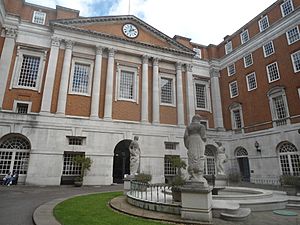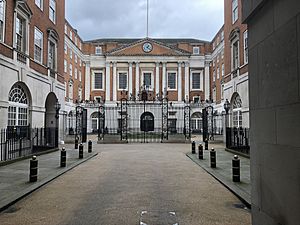British Medical Association War Memorial facts for kids
Quick facts for kids British Medical Association War Memorial |
|
|---|---|
| United Kingdom | |
 |
|
| For medical men and women from the British Empire and Commonwealth in the Second World War | |
| Unveiled | 1954 |
| Location | 51°31′34″N 0°07′42″W / 51.5261°N 0.1284°W Tavistock Square, Bloomsbury, London
|
| Designed by | James Woodford |
|
IN HONOUR OF THE MEDICAL MEN AND WOMEN OF THE BRITISH EMPIRE AND COMMONWEALTH OF NATIONS WHO GAVE THEIR LIVES IN THE SECOND WORLD WAR
|
|
|
Listed Building – Grade II
|
|
| Official name | War Memorial at British Medical Association House |
| Designated | 15 April 1988 |
| Reference no. | 1378969 |
The war memorial at British Medical Association House is located in Tavistock Square, Bloomsbury, London. It honors the brave medical men and women from the British Empire and Commonwealth who died during World War II. The British Medical Association (BMA) asked sculptor James Woodford to design it.
The memorial was officially revealed in 1954 by Sir John McNee, who was then the President of the BMA. Geoffrey Fisher, the Archbishop of Canterbury, led the dedication ceremony. This important memorial became a special "Grade II* listed structure" in 1998. This means it is a very important historical building.
Contents
Where is the Memorial?
The memorial stands in Tavistock Square. This area was first developed in 1806. It was part of a larger plan by the Duke of Bedford. Later, famous writer Charles Dickens lived in a house on this square.
The building where the memorial is, called BMA House, was built in the early 1900s. It was first designed by Edwin Lutyens. During World War I, the building was used by the military. In 1923, the BMA bought the building. They finished building it and moved their main offices there in 1925. BMA House itself became a "Grade II listed building" in 1982.
History and Design of the Memorials
There are actually two memorials at BMA House. One is for World War I, and the other is for World War II.
World War I Memorial
The memorial for medical staff who died in World War I is a large metal screen. It is about 60 ft (18 m) wide. This screen has a main gate and two smaller side gates. It stands between two courtyards at BMA House.
Above the main gate, you can see the BMA symbol. It is a golden snake wrapped around a staff. This is a symbol of medicine. There is also a shield with special words. These words honor the 574 medical officers who died in that war. The screen was designed by Edwin Lutyens. It was made by the Birmingham Guild of Handicraft.
This World War I memorial was dedicated in 1925. This was the same day that King George V and Queen Mary officially opened the new BMA building. This screen is also part of the Grade II listing for BMA House. It has been restored twice, in 1995 and 2014.
World War II Memorial
After World War II ended, the BMA asked sculptor James Woodford to create a new memorial. Woodford was known for his architectural sculptures.
This memorial features a bronze fountain. It has intertwined snakes in a circular pool. Around the pool are four statues. These statues represent important ideas: "Sacrifice," "Cure," "Prevention," and "Aspiration." The statues and the fountain are made of special stone called Portland stone. The base is made of York stone.
The side of the fountain has the words "IN MEMORIAM 1939–1945." A bronze plaque also states: "IN HONOUR OF THE MEDICAL MEN AND WOMEN OF / THE BRITISH EMPIRE AND COMMONWEALTH OF NATIONS / WHO GAVE THEIR LIVES IN THE SECOND WORLD WAR."
This memorial is located in the building's east courtyard, called the Court of Honour. Sir John McNee unveiled it on November 2, 1954. Geoffrey Fisher, the Archbishop of Canterbury, dedicated it. He spoke about how these medical people "saved others, themselves they could not and would not save." This World War II memorial was separately listed as Grade II* in 1998.


